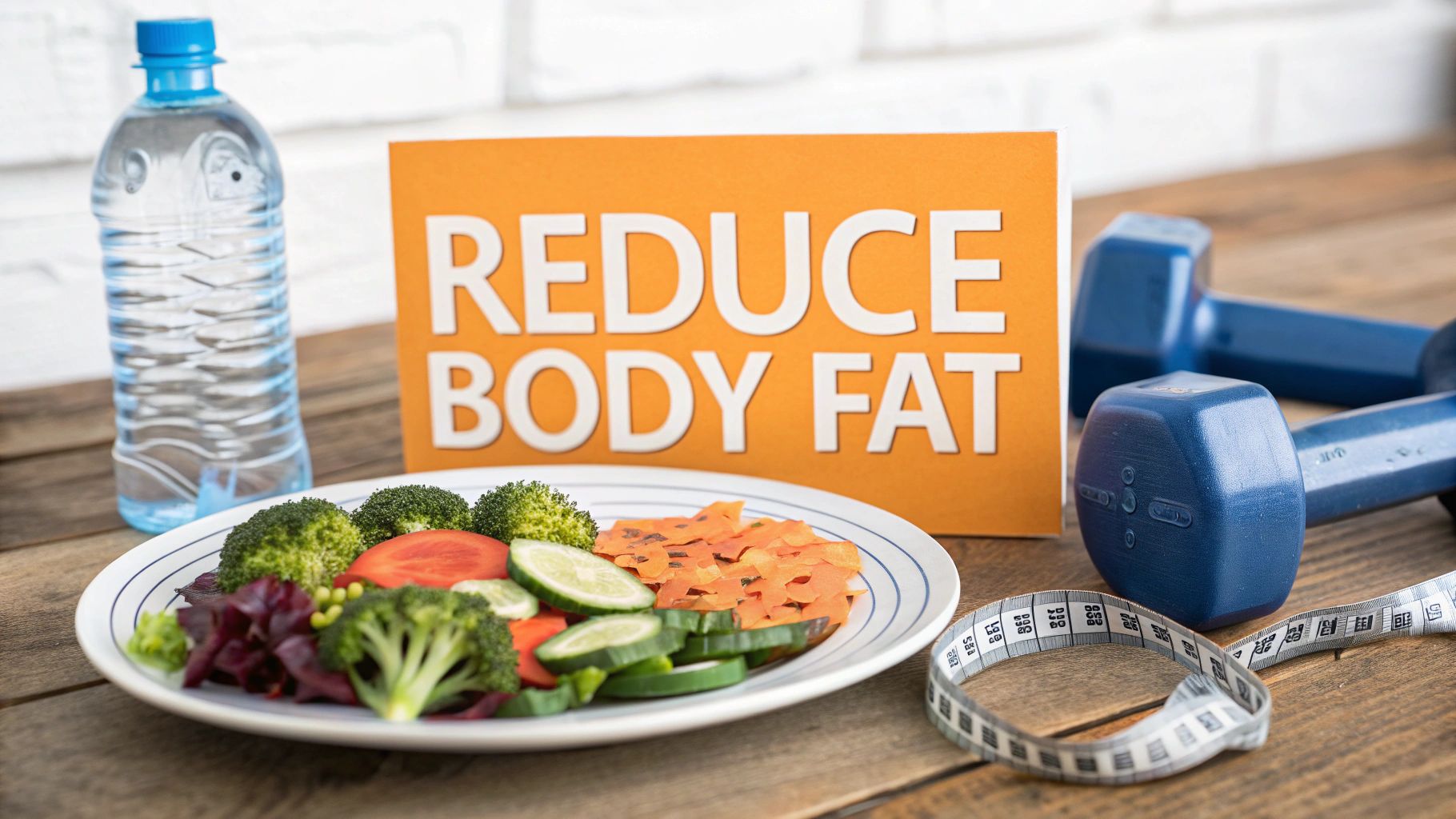To naturally boost your HGH, the answer lies in simple, powerful lifestyle shifts like high-intensity exercise, strategic eating windows through intermittent fasting, and prioritizing deep sleep. These aren't complicated hacks; they're direct signals that tell your body to ramp up its production of this vital hormone.
What Is Human Growth Hormone and Why Does It Matter?

Before we jump into the "how," it's worth understanding the "why." Knowing what Human Growth Hormone (HGH) actually does provides some serious motivation. HGH is produced by the pituitary gland—a tiny, pea-sized structure at the base of your brain—but its impact is massive. It's far more than just a hormone for "growth."
Think of HGH as your body's in-house project manager for repair and renewal. Its influence touches almost every system, going way beyond helping you grow taller as a kid.
The Critical Roles of HGH
In adulthood, HGH is a cornerstone of keeping you in your physiological prime. It’s a key player in managing body composition, signaling your body to burn fat for energy. This is a huge deal for anyone looking to shed stubborn fat and build lean muscle.
This master hormone is responsible for:
- Accelerating cell repair and regeneration: This is what helps your muscles recover after a tough workout and what speeds up healing from injuries.
- Boosting metabolism: HGH encourages your body to tap into fat stores for fuel, which is crucial for maintaining a lean physique.
- Strengthening bones: It plays a direct role in maintaining bone density, a factor that becomes increasingly important as we age.
- Supporting cognitive function: Healthy HGH levels are linked to a sharper mind, better mood, and improved concentration.
The Natural Decline and Why It Matters
Here’s the catch: your body's HGH production doesn't stay constant. It hits its peak during puberty to drive all that growth and then starts a slow, steady decline around your late twenties or early thirties. By the time you hit middle age, HGH secretion can be a fraction of what it was in your youth.
This natural drop-off is a big reason we experience things like a slower metabolism, muscle loss, and longer recovery times as we get older. Understanding this lifecycle is the first step toward taking control.
By adopting the right habits—from how you train to when you eat and how well you sleep—you can encourage your body to optimize its own HGH production. The strategies we'll cover aren't about fighting your body; they're about working with its natural systems to support vitality at any age. This is a sustainable path to feeling your best without needing external interventions.
Using High-Intensity Training to Boost HGH
If you want to unlock a powerful hormonal response, you have to move beyond the generic advice to simply "exercise more." While any activity is a good start, certain types of training send a potent signal to your body to ramp up HGH production. This isn't about spending endless hours in the gym; it's about the quality and intensity you bring to a much shorter window of effort.
The real secret is pushing your body past its comfort zone. It's this metabolic stress that triggers your pituitary gland to release a surge of growth hormone. The two most effective ways to do this are high-intensity resistance training and high-intensity interval training (HIIT).
Designing a High-Impact Resistance Workout
For lifting to really move the needle on HGH, you need to focus on intensity and creating a massive metabolic demand. That means building your workouts around big, compound movements that recruit multiple large muscle groups at the same time. We're talking about squats, deadlifts, overhead presses, and bench presses.
Here’s a practical way to structure it:
- Prioritize Compound Lifts: Build your routine around the big lifts that work your whole body. They force a much greater hormonal response than small isolation exercises like bicep curls.
- Moderate to Heavy Weight: You should be aiming for a weight you can lift for about 8-12 repetitions with solid form. The last couple of reps should be a real struggle.
- Shorten Your Rest: This is the game-changer. Keep your rest between sets to just 60-90 seconds. This limited recovery time cranks up lactic acid, which is a key signal for HGH release.
This style of training creates a significant metabolic stressor. In fact, high-volume protocols using loads around your 10-repetition maximum (10RM) with these short rest periods have been shown to spike HGH levels by up to 450% above baseline. You can get a deeper dive into the physiological effects on Physio-pedia.
Harnessing the Power of HIIT
If you're more of a cardio person or just short on time, High-Intensity Interval Training (HIIT) is an incredibly efficient way to boost HGH naturally. This method is all about short bursts of all-out effort followed by brief, easy recovery periods. The repeated spikes in your heart rate and oxygen demand create a powerful hormonal cascade.
The goal of a HIIT session is simple: push yourself hard enough during the "on" intervals that you become breathless. That's the intensity that signals your body to adapt and release growth hormone to help with recovery and repair.
You can apply this principle to almost any piece of cardio equipment or activity you enjoy.
Example HIIT Stationary Bike Session:
- Warm-up: Start with 5 minutes of easy pedaling to get your blood flowing.
- Work Intervals: Pedal as hard and fast as you possibly can for 30 seconds.
- Recovery Intervals: Slow down to a very light, easy pace for 60 seconds.
- Repeat: Go through this cycle 8-10 times.
- Cool-down: Finish up with 5 minutes of slow, easy pedaling.
This entire workout is done in less than 25 minutes, but it creates a hormonal response that can last for hours. Maintaining this balance is a core principle, and you can explore more strategies in our guide to using exercise for hormonal balance. By working these high-intensity protocols into your weekly routine, you give your body the direct stimulus it needs to optimize its own production of this vital hormone.
Fuel Your Body for Optimal Hormone Release
Beyond what you do in the gym, your kitchen holds one of the most powerful keys to unlocking your body’s growth hormone potential. The food you eat—and just as importantly, when you eat it—directly influences the hormonal signals that tell your body to release HGH. It’s all about creating an internal environment where your body is primed to produce, not suppress, this vital hormone.
The core principle here is managing your insulin. Insulin and HGH have an inverse relationship; when insulin is high, HGH is low. Meals packed with sugar and refined carbs cause a massive insulin spike, which can slam the brakes on HGH secretion for hours. This is exactly why timing your nutrition is so critical.
The Power of Intermittent Fasting
One of the most effective ways to naturally boost HGH is through intermittent fasting (IF). When you’re in a fasted state, your insulin levels drop and stay low, creating the perfect conditions for your pituitary gland to release growth hormone. And we're not talking about a minor bump; the effects can be dramatic.
Intermittent fasting essentially gives your body a break from the constant cycle of digestion and insulin release. This low-insulin window is a powerful trigger for HGH, turning your body's natural downtime into a potent period for hormone optimization.
There are a few popular ways to approach IF:
- The 16/8 Method: This is a fan favorite. You fast for 16 hours and eat all your calories within an 8-hour window (say, from 12 PM to 8 PM).
- The 24-Hour Fast: More advanced, this involves a full 24-hour fast once or twice a week.
This infographic shows just how much certain activities can spike HGH levels, highlighting the body's powerful response to intense stimuli.

The data here makes it clear: both high-intensity aerobic and resistance training create a massive hormonal surge. Smart nutritional strategies are what support and amplify that effect.
Strategic Nutrient Timing and Key Amino Acids
To really get a handle on how to increase HGH naturally, you have to think about what you eat around key times like workouts and bedtime. A big meal, especially one high in carbs, right before you turn in for the night can blunt the massive HGH pulse that naturally occurs during your first few hours of deep sleep. A better approach is to finish your last meal at least two to three hours before you go to sleep.
Certain nutrients, particularly amino acids, also play a direct role. These are the building blocks of protein, and some can stimulate HGH release all on their own. The results from nutritional studies have been incredible; one found that an oral amino acid supplement led to an 8-fold (682%) increase in HGH levels. In another, a 24-hour fast boosted HGH by a median of 720% in women with low baseline levels.
Here is a quick look at some effective dietary approaches to support your body's natural HGH production.
Key Nutritional Strategies to Boost HGH
| Strategy | Mechanism of Action | Practical Application |
|---|---|---|
| Intermittent Fasting (IF) | Keeps insulin levels low, which removes the primary inhibitor of HGH secretion. | Adopt a 16/8 eating window or a weekly 24-hour fast to create extended periods of low insulin. |
| Avoid Pre-Bed Carbs | A carbohydrate-heavy meal spikes insulin, blunting the natural HGH pulse that occurs during deep sleep. | Finish your last meal at least 2-3 hours before bed, focusing on protein and healthy fats. |
| Increase Amino Acid Intake | Certain amino acids like Arginine, Ornithine, and Glutamine directly stimulate the pituitary gland to release HGH. | Incorporate foods rich in these aminos (turkey, chicken, dairy, eggs) or consider targeted supplementation. |
| Reduce Sugar Intake | High sugar consumption leads to chronically elevated insulin, which consistently suppresses HGH production throughout the day. | Cut out sugary drinks and refined carbohydrates. Focus on whole foods with a lower glycemic index. |
By implementing these strategies, you create a hormonal environment that encourages, rather than hinders, optimal HGH release.
While supplements are an option, you can get these powerful compounds straight from whole foods:
- Arginine: Found in turkey, chicken, pumpkin seeds, and dairy.
- Glutamine: Present in eggs, beef, skim milk, and tofu.
- Ornithine: Can be found in fish, meat, and dairy products.
Ensuring you get enough of these key nutrients is essential for your body’s building and repair processes. Proper timing is also a big piece of the puzzle, which is why understanding the best time to take vitamins and other micronutrients can round out your nutritional strategy for peak hormonal health.
Mastering Your Sleep for Nightly HGH Surges

While intense training creates the stimulus and smart nutrition provides the fuel, the single biggest release of HGH happens when you’re not even conscious. The vast majority of your daily growth hormone is released in powerful pulses during deep, slow-wave sleep.
This makes your sleep quality a non-negotiable pillar if you're serious about optimizing your hormones.
You can't just go through the motions. You have to transform sleep from a passive activity into an active recovery tool. Think of it as your nightly repair cycle where your body gets to work rebuilding tissue, and HGH is the lead foreman on the job. Without this critical window, you're leaving massive hormonal benefits on the table.
This is where the science becomes incredibly clear: sleep deprivation is a direct enemy of HGH. Research shows that even a single night of poor sleep can slash your body's HGH secretion by up to 70%.
Consistent lack of sleep, especially when adults get less than 6 hours, leads to significantly lower HGH levels compared to those getting a full 7-9 hours. One study found that participants who simply extended their sleep from 6 to 8 hours a night saw a 20-30% increase in HGH secretion within just four weeks.
Creating Your Ideal Sleep Environment
Your bedroom should be a sanctuary dedicated to one thing: rest. It's not a multi-purpose entertainment hub. The goal is to eliminate any sensory input that could interfere with your ability to fall asleep and, just as importantly, stay asleep.
You'd be surprised how small adjustments to your environment can lead to huge improvements in sleep quality.
- Make it Cool: Your body temperature naturally needs to drop to initiate sleep. I've found the sweet spot for most people is a room temperature between 60-67°F (15-19°C).
- Make it Dark: Light, especially the blue light from screens, is a potent suppressor of melatonin—the hormone that signals your brain it's time to sleep. Blackout curtains are a game-changer.
- Make it Quiet: Unpredictable noises can easily pull you out of deep sleep. A white noise machine or even simple earplugs can create a consistent, peaceful soundscape that masks disruptions.
Your body craves routine. By creating a consistent, optimized sleep environment, you're sending powerful signals to your brain that it’s time to wind down and begin the crucial process of releasing restorative hormones like HGH.
The Non-Negotiable Wind-Down Routine
What you do in the hour before bed has a massive impact on your sleep quality. Blasting your brain with stimulation from screens, caffeine, or alcohol is a surefire way to sabotage your nightly HGH surge. Instead, you need to create a calming pre-sleep ritual.
This routine should focus on lowering your heart rate and quieting your mind, signaling a clear transition from the stress of the day to a state of rest. This is especially vital for athletes and active individuals whose bodies are screaming for that deep recovery period. For more ideas on enhancing your body's repair cycles, check out these highly effective recovery methods for athletes.
Actionable Wind-Down Ideas:
- Ditch the Screens: Turn off all phones, tablets, and TVs at least 60 minutes before bed. The blue light is a known sleep disruptor. No exceptions.
- Try Light Reading: Opt for a physical book instead of an e-reader to avoid that screen exposure.
- Take a Warm Bath: The drop in body temperature after you get out actually mimics the natural temperature drop that occurs as you fall asleep, tricking your body into a state of rest.
- Practice Mindfulness: Just a few minutes of meditation or deep breathing can significantly lower cortisol levels, making it much easier to drift off.
By mastering your sleep, you are directly tapping into your body’s most powerful, natural mechanism for HGH production.
Lifestyle Tweaks and Supplements That Move the Needle
Once you’ve locked in your training, diet, and sleep, you might think you’ve done it all. But there are a few other powerful levers you can pull to really fine-tune your hormonal environment.
Think of these as complementary strategies—the missing pieces that help your body produce HGH as efficiently as possible. It starts with one of the biggest hormone disruptors out there: excess body fat.
Your body composition has a direct, inverse relationship with your HGH production. The more body fat you carry, especially that stubborn visceral fat around your midsection, the less growth hormone your body tends to secrete. Research has consistently shown that people with higher levels of abdominal fat have blunted HGH release.
Getting leaner isn't just for looks. It's about lowering systemic inflammation and boosting your insulin sensitivity. Both of these changes create the ideal internal conditions for stronger, more frequent HGH pulses, making every bit of effort you put into your workouts and diet count for more.
Managing Stress to Lower Cortisol
Chronic stress is the silent killer of hormonal health. When you're constantly running on adrenaline, your body is flooded with cortisol, a hormone that's essentially the arch-nemesis of HGH.
Picture a seesaw: when cortisol goes up, HGH is pushed down. It’s a direct antagonism. This is why learning to manage stress is non-negotiable if you truly want to know how to increase HGH naturally. You have to give your body a break from that constant "fight-or-flight" state so many of us live in.
You don’t need an elaborate retreat. Simple, consistent habits are what make the real difference:
- Mindfulness or Meditation: Just 5-10 minutes a day can have a profound effect on lowering cortisol and calming your entire nervous system.
- Spending Time in Nature: There’s a reason a walk in the woods feels so good. Getting outside is a proven way to slash stress and reset your mind.
- Deep Breathing Exercises: Taking slow, deliberate breaths is a direct signal to your body that it's safe to relax, activating your "rest and digest" nervous system.
By actively managing your stress, you're doing more than just improving your mood. You're clearing the biological runway for your body to produce more growth hormone. It’s an incredibly powerful part of the optimization puzzle that most people overlook.
A Sensible Approach to Supplementation
Let’s be clear: no pill or powder can ever replace the hard work of training and clean eating. However, a few select supplements have shown some real promise in supporting the body's natural HGH output. It's an area you should approach with a healthy dose of skepticism and always run by a healthcare professional first.
Here are a few compounds backed by some interesting research:
- GABA (Gamma-Aminobutyric Acid): As a neurotransmitter that promotes relaxation, GABA can help improve your sleep quality. This can indirectly support the massive HGH surge that happens during the deepest stages of sleep.
- Melatonin: We all know it as a sleep aid, but some studies suggest melatonin might also directly nudge the pituitary gland to release more HGH.
- Amino Acid Blends: Certain aminos like arginine, ornithine, and glutamine seem to have a direct stimulatory effect on HGH, especially when you take them on an empty stomach away from other meals.
Treat these as supportive tools, not magic bullets. They work best when your lifestyle is already dialed in. Think of them as the final 5% tweak that can help you sharpen your results after all the heavy lifting is done.
Common Questions About Boosting HGH Naturally
As you start putting these ideas into action, you're bound to have some questions. Getting straight answers is the best way to move forward safely and see real results. Let’s tackle some of the most common things people ask when they decide to increase HGH the natural way.
How Long Until I See Results?
This is the big one, and honestly, the timeline is different for everyone. You'll feel some effects right away—that rush of energy after a killer high-intensity workout is a direct HGH spike. But for the more substantial changes like seeing a difference in the mirror, recovering faster, and sleeping like a rock, you need to be consistent.
Think in terms of weeks and months, not days. Most people start noticing real, tangible benefits within 8 to 12 weeks of consistently applying these principles. Lasting hormonal balance is a long game built on solid habits, not a quick fix.
The key is synergy. These strategies work best when you stack them. A tough workout creates the demand, a protein-rich diet gives your body the building blocks for repair, and deep sleep is when HGH is released to do the heavy lifting. They amplify each other for much bigger results.
Are There Any Risks Involved?
The beauty of these natural methods is that they’re all cornerstones of good health, so they’re generally very safe. Smart exercise, a whole-foods diet, quality sleep, and keeping stress in check are all incredibly beneficial with almost no downside.
The main risks really only show up at the extremes. Pushing way too hard in the gym before your body is ready can lead to injury, and trying a long fast without knowing what you're doing can be problematic. The golden rule is simple: always listen to your body’s signals.
Can I Combine These Strategies?
Absolutely—in fact, you should. Combining them is the secret sauce to maximizing your results. They aren’t separate tactics but interconnected parts of a holistic system.
For example, lifting weights signals the need for muscle repair, and the HGH released during your deep sleep cycle is what actually executes that repair. One without the other is far less effective. By weaving together your diet, exercise, and sleep habits, you create a powerful, self-reinforcing cycle that supports optimal hormone levels around the clock.
At Elite Bioscience, we believe in giving you the knowledge and tools to take full control of your health. If you're ready to see how targeted therapies can complement your natural efforts, discover your options at our official site.







